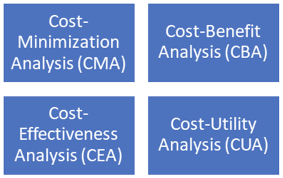Whether a device or procedure is covered as reimbursable, and at what amount, can have a significant impact on a provider's ability to access a particular technology, as well a manufacturer's ability (or willingness) to provide it.
Before purchasing a new medical device, performing an economic analysis is essential. Before investing in a pharmaceutical product or a medical device company, a payer must evaluate the economic value of the proposed intervention. The device should improve patient outcomes and maintain cost-effectiveness to a designated clinic or practice.
Cost Benefit Analysis
Cost Benefit Analysis (CBA) is a way to compare the costs and benefits of an intervention, where both are expressed in monetary units (dollars).
Cost Benefit Analysis (CBA) is a way to compare the costs and benefits of an intervention, where both are expressed in monetary units (dollars).
Costs including those of implementing an intervention, program, or unnecessary ER utilization due to better primary care access.
Benefits including those resulting from an intervention, such as medical costs averted, productivity gains, and the monetized value of health improvements.
Decision makers can also use CBA to compare health and non-health interventions. For example, CBA could be used to compare health and environmental interventions.
In addition to proving a program's value in dollars, CBAs can improve internal operations by helping to identify what works and what doesn't, and by directing internal resources to those interventions or components that work best.
Cost Benefit Analysis is one way to demonstrate to funders, government agencies, managed care organizations (MCOs), and other audiences that your program is effective.
Cost Effectiveness Analysis
Cost Effectiveness Analysis (CEA) is a way to examine both the costs and health outcomes of one or more interventions. It compares an intervention to another intervention (or the status quo) by estimating how much it costs to gain a unit of a health outcome (life year gained or a death prevented).
Because CEA is comparative, an intervention can only be considered cost effective compared to something else.
Net cost is the intervention costs minus averted medical and productivity costs.
Changes in health outcomes are outcomes with the intervention in place minus outcomes without the intervention in place.
Examples of health outcomes include heart attacks and deaths from heart disease.




Cost per Outcome: The Cost Effectiveness Ratio
CEA results are presented as the cost per positive health outcome, such as cost per case prevented, cost per year of life saved, or cost of quality-adjusted life years. CEA results are used to allocate healthcare resources.
A CEA expresses this trade-off using a metric called the incremental cost-effectiveness ratio (ICER). The ICER can be regarded as a "price" for an additional unit of health gained through an intervention. Like lower prices, a smaller ratio is more favorable because it implies that an intervention can produce an incremental health gain at a lower cost.
Cost Effective versus Cost Savings
A strategy that is said to be "cost-effective" means that the new strategy is a good value. Being cost-effective does not mean that the strategy saves money. Just because a strategy saves money does not mean it is cost-effective. The very notion of cost-effective requires a value judgment; what one thinks is a good price for improved clinical outcomes.
Both CBA and CEA include health outcomes. However, CBA places a monetary value on health outcomes so that both costs and benefits are in monetary units (such as dollars).
Contact Us
949-701-5507
aschechter@alba-consultants.com




